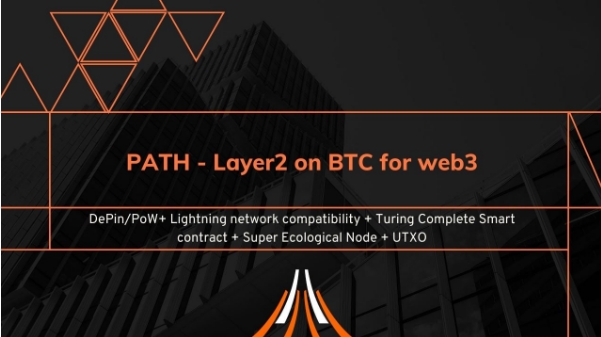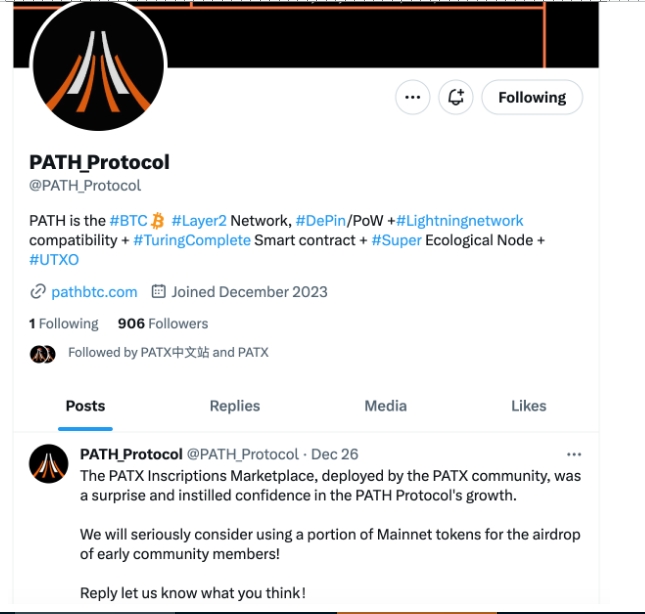An Overview of the BTC Layer 2 Scaling Protocol PATH Protocol
Author: 0xdabai
Recently, the BRC-20 inscription PATX has attracted significant attention, with a trading volume exceeding 16 BTC in 48 hours. This article will delve into the BTC Layer2 protocol that the PATX community aims to promote—Path Protocol.
The explosion of inscriptions and the development of Bitcoin Layer2 technology have garnered close attention from the industry. Although Bitcoin is renowned for its security and decentralization, its ability to handle a large number of transactions is limited by its finite transaction speed. This challenge has led to a demand for Layer2 solutions. As a part of this transformation, the PATH Protocol will play a key role in driving the entire Bitcoin ecosystem towards a more mature and diversified direction.
The PATH protocol is entirely based on Bitcoin consensus's Layer2 infinite scalability solution, which can be understood from three dimensions.

Cross-Chain
In the decentralized world, various crypto assets in the blockchain industry are the cornerstone of the Web3 ecosystem. Therefore, asset cross-chain is a fundamental capability and one of the driving forces behind PATH.
The PATH protocol implements cross-chain through a hybrid system that utilizes both relay and notarization mechanisms. The states of other blockchain systems are opened to the PATH protocol through relays, allowing applications on the PATH protocol network to freely query the states of other blockchain systems. Meanwhile, cross-chain instructions from the PATH protocol are issued to other blockchain systems in the form of notarization. Before the release of the cross-chain components in the PATH protocol network, the notarization mechanism must be implemented to facilitate subsequent migration. A decentralized fairness mechanism is achieved through KYC of founding nodes, staking assets of committee nodes, forming a temporary committee through the VRF algorithm, and supervising malicious nodes through periodic reporting and multi-signature.
Scalability
Nodes in the decentralized network of the PATH protocol maintain ledger data and the standards and rules for mutual interaction. These nodes operate independently in the network environment, exchanging information and forming a scalable, efficient, and tamper-proof decentralized infrastructure.
The PATH protocol ultimately proposes a decentralized public ledger protocol PATH, which can scale performance, throughput, and storage capacity while ensuring security. To achieve high throughput and low latency, the ledger decouples transactions into two parts: initiation and reception, created by different accounts. Since the creation of blocks by different accounts does not affect each other, this model can achieve significant storage and throughput elasticity after introducing the settlement state of blocks. Unlike Nano's account model, PATH supports a variety of assets and, through the Merkle tree of accounts, supports Key-Value storage data.
In addition to meeting the business needs of feasible smart contract applications, PATH's decentralized applications also possess more flexible and higher-level definitions. Besides enabling complex decentralized applications, it also supports oracles, authoritative nodes, cross-chain applications, and more. The advantages of PATH's high throughput and low latency system architecture bring the experience of decentralized applications closer to that of centralized applications.
The PATH protocol scales Turing-complete smart contracts, supporting decentralization, EVM compatibility, high performance, and high scalability, as well as compatibility with the Lightning Network.
The First Implementation of a Scalability Subchain
PATH will soon release the first Layer2 chain based on the PATH framework to meet the requirements for running smart contracts and high scalability, which is crucial for building a practical application platform. This will be achieved through the following technologies to enhance the underlying architecture of the chain.
It adopts the PATH-Random consensus mechanism, which is designed to balance fairness and efficiency by combining PBFT theory and VRF algorithms.
It utilizes Plasma blockchain scaling computation, where numerous blockchains are combined into a tree structure to collectively participate in computation, achieving horizontal scaling of the blockchain.
It employs a more powerful virtual machine that not only meets EVM compatibility but also has sufficient scalability and a foundational layer of instructions to meet performance requirements.
About PATH Protocol
PATH Protocol is entirely based on Bitcoin consensus's Layer2 infinite solution. Based on the Depin/POW consensus mechanism's UTXO model, it thoroughly resolves scalability issues while supporting the consensus security of core assets sharing the BTC network and Turing-complete smart contracts, fully compatible with mainstream EVM systems, and supporting one-click migration and deployment of mainstream DApps, aiming to become the cornerstone facility of the BTC network's Web3 ecosystem.

According to official Twitter news from PATH Protocol, community members holding PATX inscriptions may receive airdrops from the PATH protocol, and the community is confident that these inscriptions will achieve more significant market performance in the future.
PATH Protocol
Website: https://www.pathbtc.com/
Twitter: https://twitter.com/PATH_Protocol
PATX Inscriptions Chinese Twitter: https://twitter.com/PATXBTCL2CN
English Twitter: https://twitter.com/PATXBTCL2









